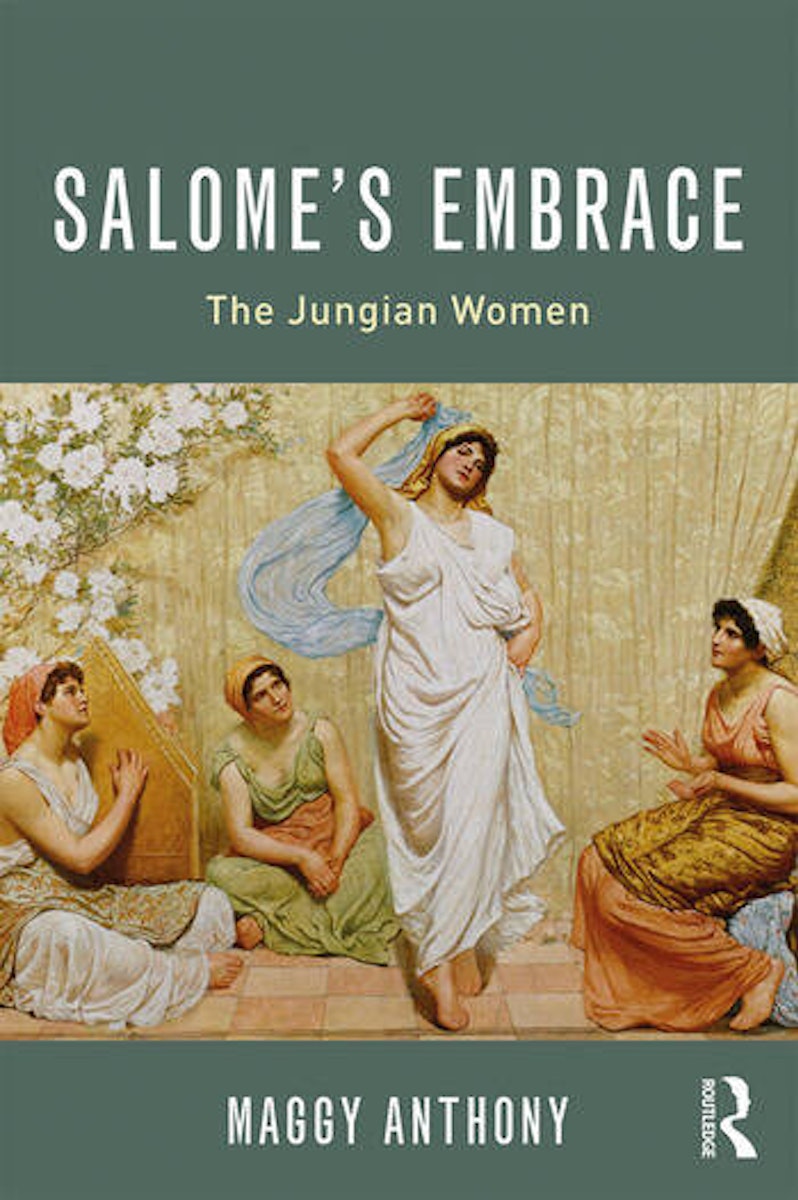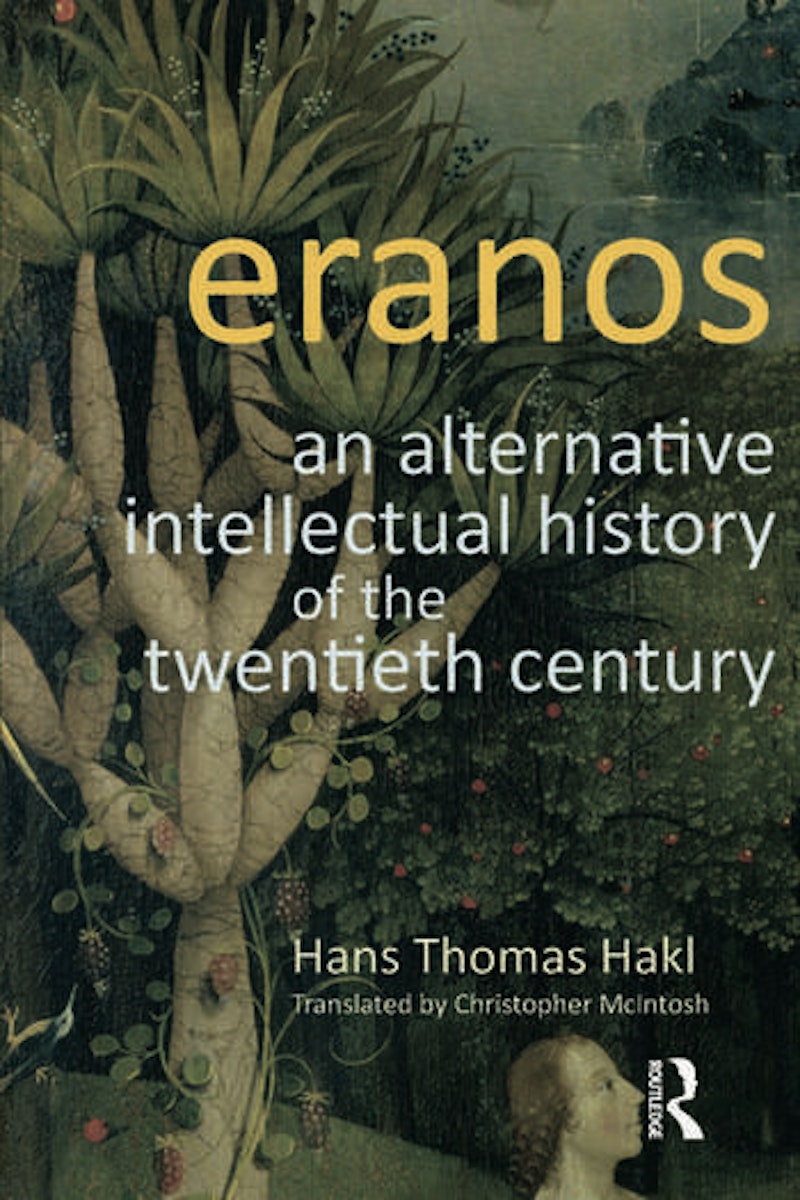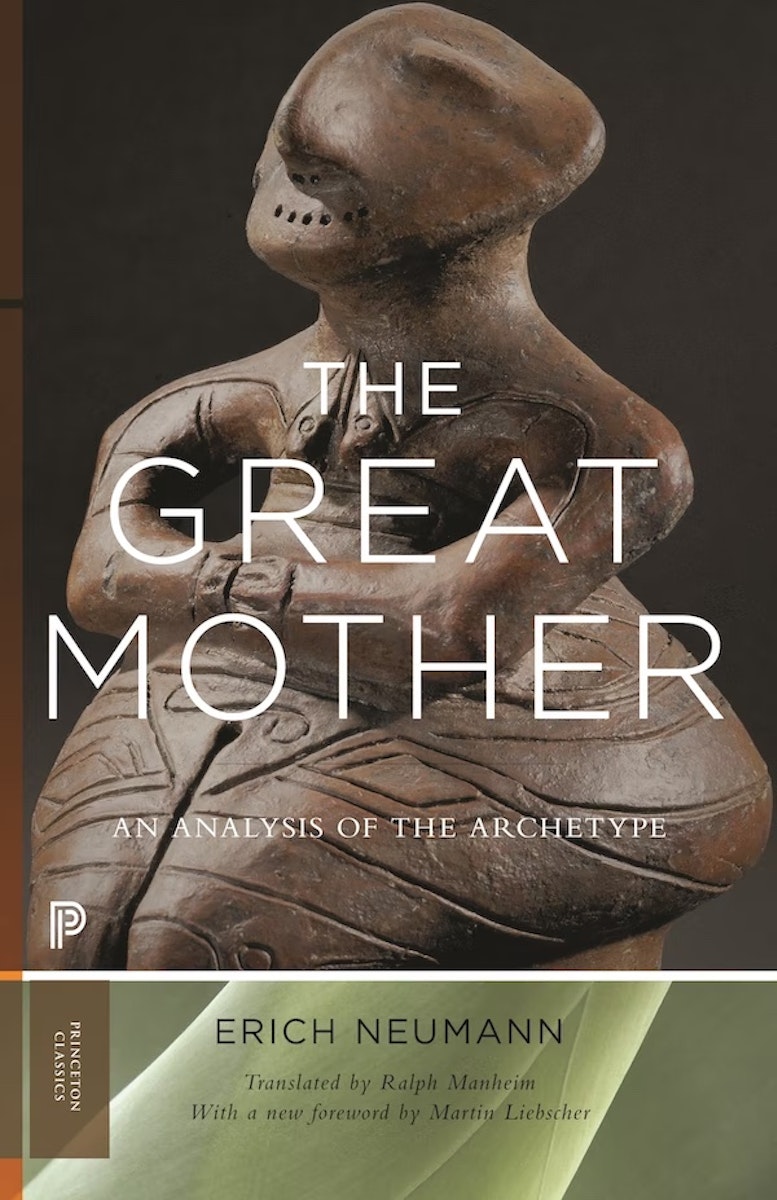
Images from the Collective Unconscious Olga Fröbe-Kapteyn and the Eranos Archive
In the 1930s, Olga Fröbe-Kapteyn, mystic and founder of the multidisciplinary Eranos forum, began compiling a diverse visual archive that would allow dreamers to cross-reference their visions with the entirety of cultural history. Frederika Tevebring explores this grandiose undertaking and its effect on the archivist, as images from the collection began to blur with her psyche.
February 22, 2023
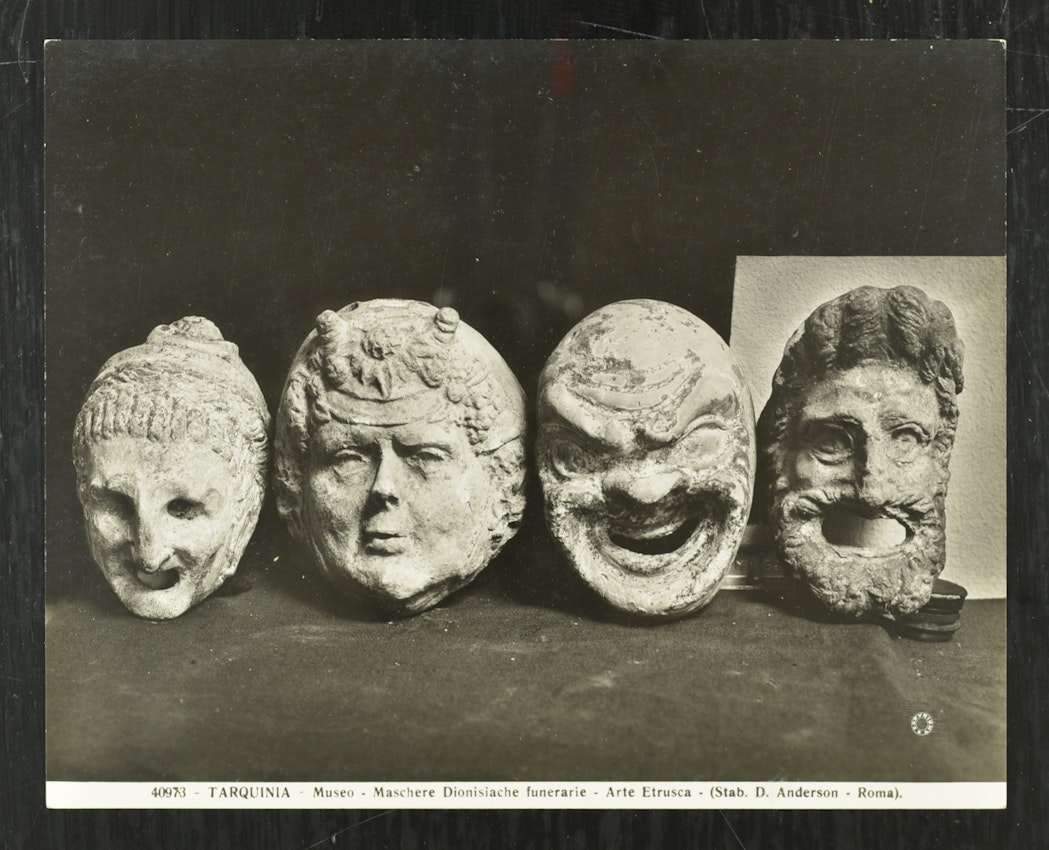 Scroll through the whole page to download all images before printing.
Scroll through the whole page to download all images before printing.Etruscan “Dionysian funerary masks” in Tarquinia, Italy, photographed by Domenico Anderson’s firm in the early 20th century. Author’s own photograph from the Eranos Archive at the Warburg Institute, London.
In the 1930s, Olga Fröbe-Kapteyn (1881–1962), artist, mystic, and founder of the multidisciplinary forum Eranos, began assembling an extensive archive of images.1 Its purpose was to offer a “respite from logical thinking in words and concepts”, relying instead on the “magic wand of analogy”.2 The archival project was grounded in Carl Gustav Jung’s notion of the collective unconscious, which he considered to be a universal part of the human mind, holding memories inherited from our ancestors. Accordingly, Fröbe saw her collection’s images as archetypes — memories from the deep religious and symbolic past as they manifested across different cultures and epochs. Its eclectic categories included: the Trinity, Masks (with subcategories: double-faces, miscellaneous, and Swiss), Navajo Sand Painting, Fish, and Three-Headed Gods. These headings reflected Jung’s theories, Fröbe’s conversations with some of the most radical academics of the time, and her personal journey towards psychological introspection.
The archive grew in parallel to Fröbe’s wider Eranos project. Starting in 1933, she organized the annual Eranos conferences at her home in Ascona, Switzerland, handpicking speakers — from across fields such as psychoanalysis, art history, comparative religion, oriental studies, archaeology, and biology — and overseeing the publication of accompanying yearbooks. The speakers looked to symbols and mythology to track the changing forms of religious experience: “backwards into cultural history and forwards to the mental problems of today’s humanity”.3 Fröbe’s ambition was that the image archive would grow into an institution and become a tool for research and instruction in the spirit of Eranos. Her project inspired thinkers such as the myth theorist Joseph Campbell and the psychoanalyst Erich Neumann, who based his book The Great Mother (1955) on the image collection.
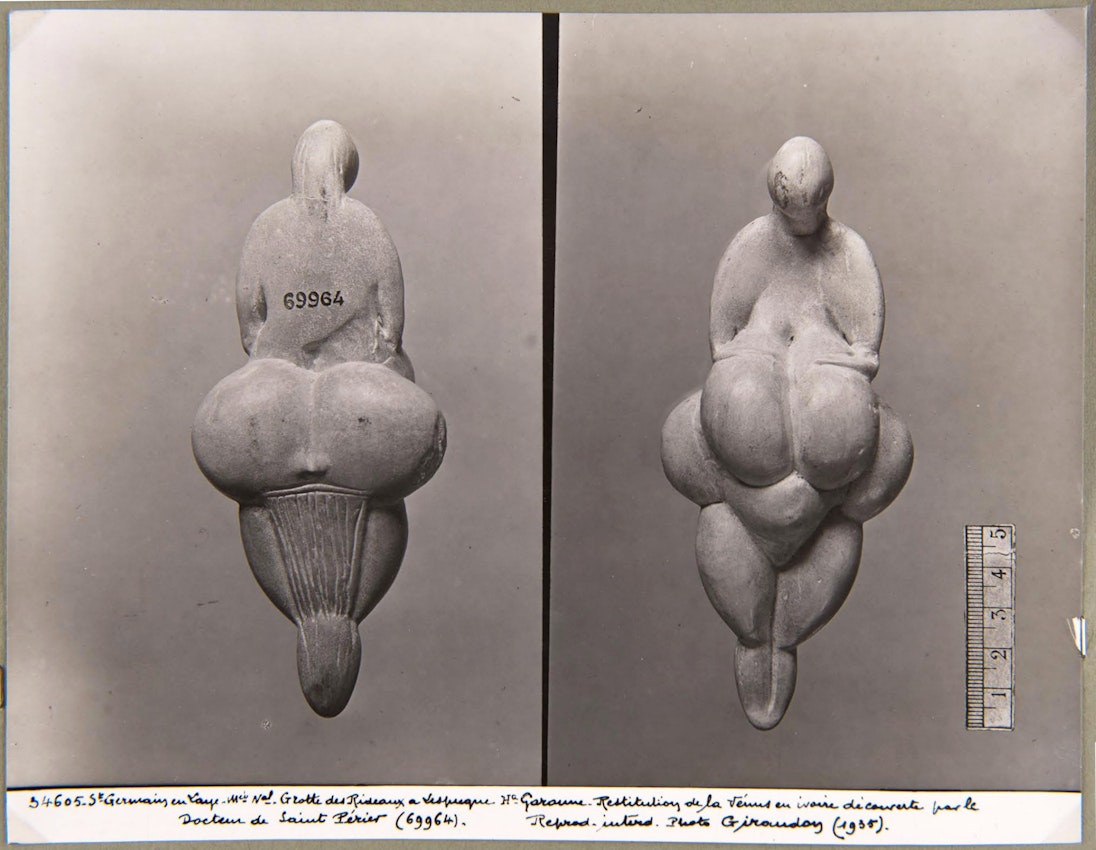 Scroll through the whole page to download all images before printing.
Scroll through the whole page to download all images before printing.Photograph, credited to the Giraudon Studio from 1935, of the Vénus de Lespugue, recovered from the Grotte des Rideaux cave in Lespugue, France, ca. 25,000 BCE. Archived by Olga Fröbe-Kapteyn under “The Great Mother” — Source (courtesy of the Warburg Institute, non-commercial use permitted).
One prominent intention of Fröbe’s archive was to decipher the archetypes that appear in dreams. In its complete form, this archive would expand beyond images and supposedly allow the dreamer to cross-reference their visions with the entirety of past and present human culture. To interpret dreams, visitors would be able to draw upon different “departments” sorted by: pictures (mostly archaeological and ethnographic); texts (e.g. from Christian mystics, alchemic treatises, and Eastern and Western systems of yoga and meditation); other people’s dreams (historical and contemporary, collected and organized according to their archetypal content); excerpts from the works of Jung; and a reference library consisting of the “[w]orks on the primitives. Their culture, religion and art” as well as:
a. The scriptures of the world. (in english, french and german
b. The myths of all time and people
c. Folklore, fiarytales of all ages and races. [sic]4
In a letter to Ximena de Angulo, a close friend interested in disseminating the ideas of Eranos in the US, Fröbe imagined how such an archive might function for the dreamer:
Lets say I dream of a ship, whose mast is a Christmastree, and a lion and a snake are sitting at its foot. (this is an imaginary dream). I would first look up either the pictorial folder of ship pictures, or of the Tree of Life. There I should find picture material, with reference Nos to the Text department, and also to the Dream department, in which other dreams of ships and trees etc occur. With this picture, text and dream material I could work out my own dream very thoroughly.5
If realized, this interpretative dream machine would have been the culmination of Fröbe’s lifework. When it had reached its full potential, the archive would serve as the basis for a “new history of art written from the standpoint of the archetypal representation”.6 It was, she wrote, “an Eranos baby, born in the darkest hour of European chaos”.7
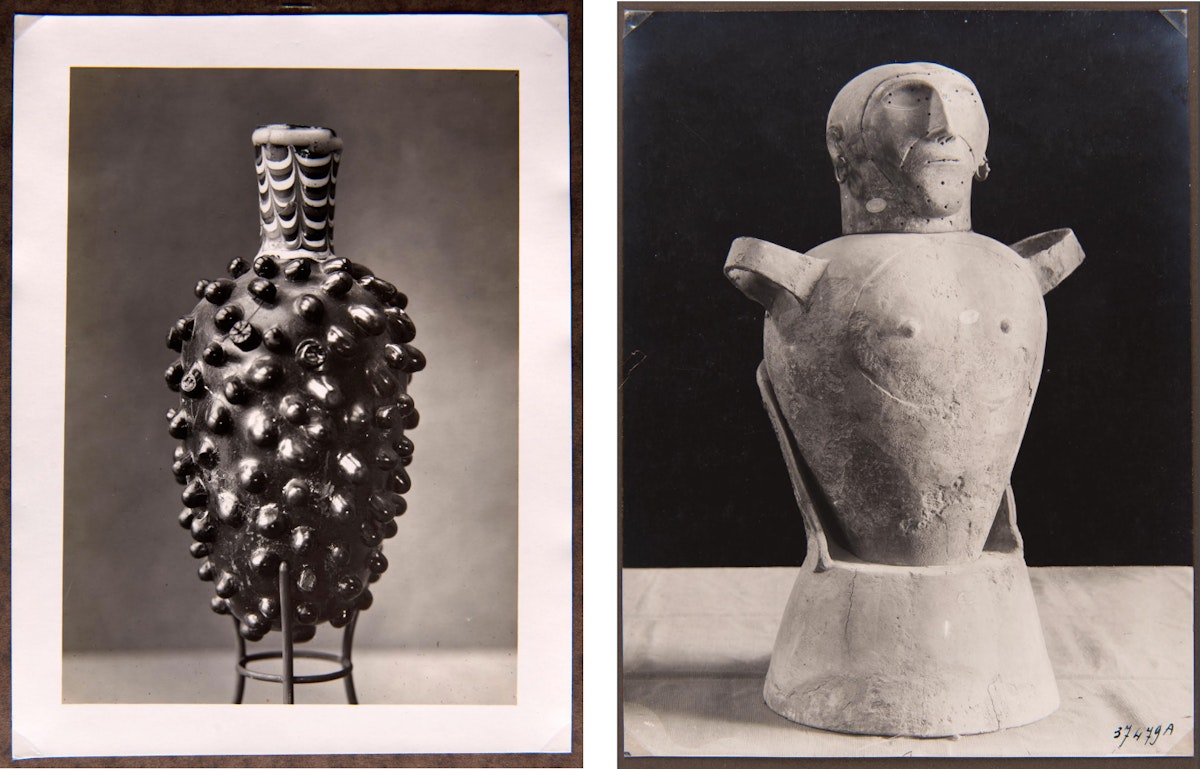 Scroll through the whole page to download all images before printing.
Scroll through the whole page to download all images before printing.Left: photograph of a Greek vase, dated 5th century BCE, with hobnail texture from the Louvre’s collection. Right: photograph of an Estrucan canopic urn, ca. 700 BCE, held by the Museo Civico in Chiusi, Italy. Both images were archived by Olga Fröbe-Kapteyn under “The Great Mother” — Source: left, right (courtesy of the Warburg Institute, non-commercial use permitted).
When World War II began, Fröbe felt that her database was more necessary than ever. In her correspondence, she insisted that cultural pursuit and intellectual introspection was what the war-torn continent needed most: Eranos was a haven for these pursuits and, as an institute, would set the tone for a new age of humanity once the unrest had settled. In one of her frequent moments of grandiose ambition, Fröbe described her project as the basis for a “comprehensive science of the soul”.8 Eranos would be able to address the “problems of today’s humanity” from the perspective of the psyche rather than material concerns. The world needed to know about Jung’s theory of archetypes, and her envisioned archive would serve as the inductor. The Eranos image archive was supposed to illustrate the constants of the human psyche across time and place. Yet the archive’s history — its emergence during war, the intimate link between the collection and Fröbe herself — raises still-relevant questions about the relationship between the psychological and the material world, between the individual and the collective, and the place of introspection in a time of violence.
The Mountain of Truth
Olga Fröbe-Kapteyn was born into an artistic and politically active Dutch family living in London. She studied at Zürich University of Arts and although she did not make a living as an artist, she would produce hundreds of vivid abstract paintings inspired by Eastern mandalas and her esoteric visions. After a period in Berlin, she returned to Switzerland following her husband’s premature death and settled outside of Ascona, a municipality bordering Italy on the shore of Lake Maggiore.
 Scroll through the whole page to download all images before printing.
Scroll through the whole page to download all images before printing.Screen-printed mandalas by Olga Fröbe-Kapteyn, titled “The Divine Breath”, “Om Mani Padme Hum”, and “The Light of the Soul”, ca. 1930 — Source (Art Institute of Chicago, William McCallin McKee Memorial and Mr. and Mrs. Henry C. Woods endowment funds: in copyright in most countries).
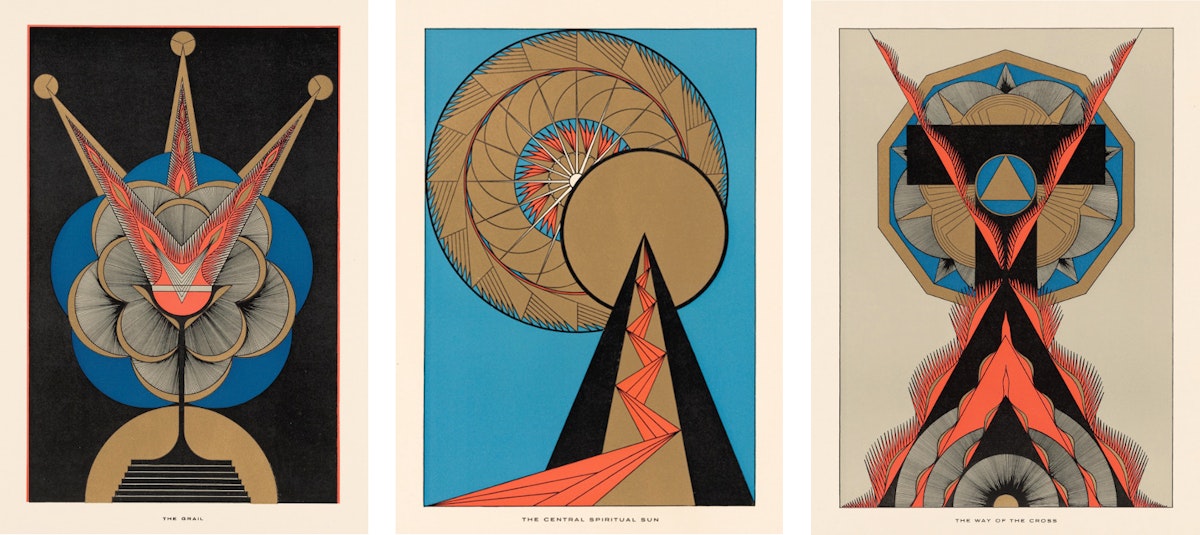 Scroll through the whole page to download all images before printing.
Scroll through the whole page to download all images before printing.Screen-printed mandalas by Olga Fröbe-Kapteyn, titled “The Grail”, “The Central Spiritual Sun”, and “The Way of the Cross”, ca. 1930 — Source (Art Institute of Chicago, William McCallin McKee Memorial and Mr. and Mrs. Henry C. Woods endowment funds: in copyright in most countries).
At the end of the nineteenth century, Ascona had begun to attract those seeking an alternative to modern life. On Monte Verità, the “mountain of truth”, anarchists, nudists, and vegetarians experimented with communal living, free love, and plotted a utopian society. Over the decades, it played host to sharp critics of technology and capitalism, as well as to many who shaped the aesthetics and philosophies of modernism. Visitors included: the artists Sophie Taeuber-Arp, Jean Arp, and Paul Klee; anarchists and socialists such as August Bebel, Peter Kropotkin (an old friend of Fröbe’s mother), Otto Braun, as well as Lenin, Trotsky, and Bakunin; the dancers Isadora Duncan and Rudolf von Laban; and poets, authors, and philosophers like Hermann Hesse, Thomas Mann, Stefan George, and Rudolf Steiner.
In 1905, the German anarchist Erich Mühsam dreamt of Ascona serving as a refuge for “freed or escaped prisoners, for the pursued homeless”, and for everyone else unfit or unwilling to become productive members of capitalist society.9 As the area became increasingly fashionable and a magnet for minor European nobilities with esoteric interests, a German journal identified Ascona as “Berlin’s outermost suburb”. “Anyone from the German literati in search of a vacation spot that comes with the possibility of a think piece guaranteed to be accepted by any paper should make their way to Ascona”, the journalist stated, promising that here you can discover “a lizard . . ., a movie star, or a new religion”.10 Bolstered by Swiss neutrality, Ascona evolved into a place where disenfranchised aristocrats rubbed shoulders with revolutionaries, while keeping close connections to the avant-garde art scene of Zürich.
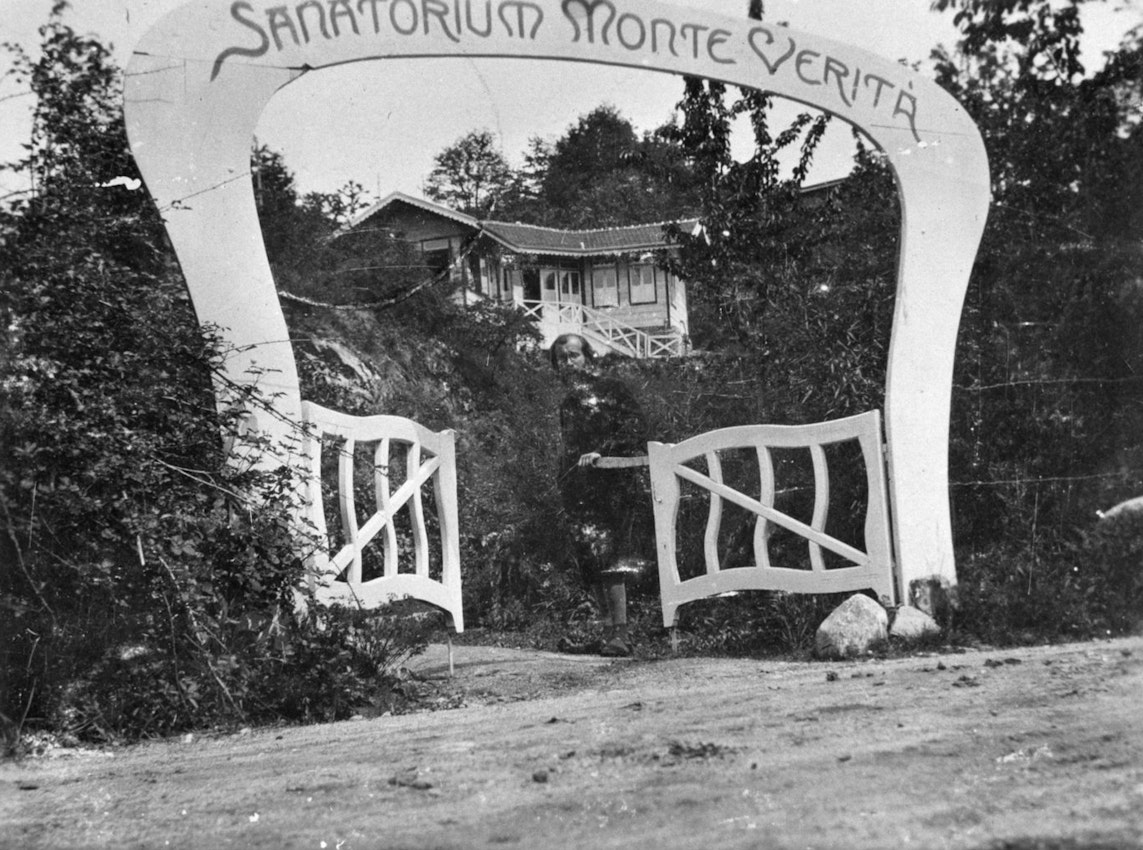 Scroll through the whole page to download all images before printing.
Scroll through the whole page to download all images before printing.The entrance gate to Sanatorium Monte Verità, Ascona, Switzerland, ca. 1907 — Source.
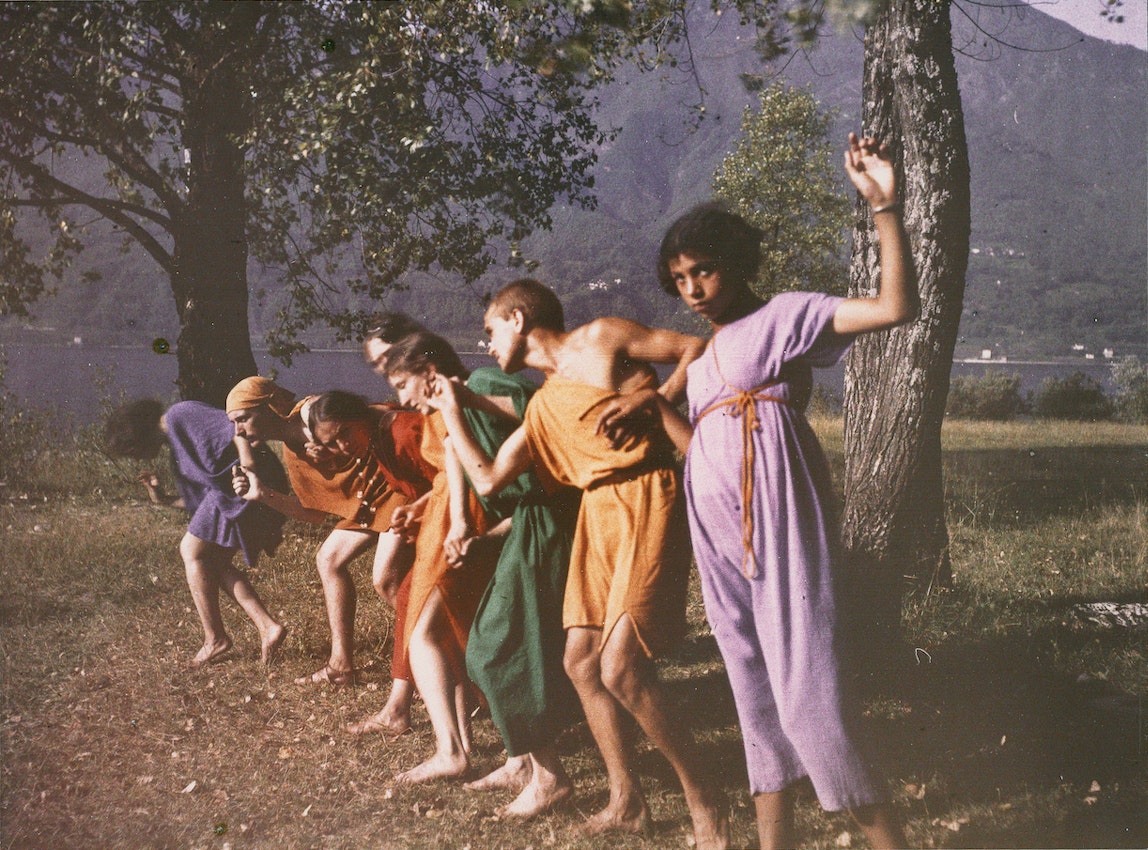 Scroll through the whole page to download all images before printing.
Scroll through the whole page to download all images before printing.Photograph of Rudolf von Laban's dance company on the shores of Lake Maggiore, near Ascona, in 1914 — Source.
Fröbe settled in Ascona during the 1920s, at some polite distance from the radicals on the mountains (during a lecture on Taoism by Martin Buber she demanded a chair while the rest of the audience sat on the grass).11 Here, she painted, practised yoga, and studied Eastern religions. In 1928, impelled by one of her frequent visions, she commissioned a conference room to be built on the slopes of an erstwhile vineyard next to her house, even though she was not yet certain what kind of meetings it would host. Casa Eranos, as the building came to be known, found its first purpose in 1930, when Fröbe and the theosophist Alice Bailey (who had coined the term “New Age”) began to use it for spiritual summer schools.12 Bailey left Ascona in 1932 after relations between her and Fröbe soured. The meetings had become too academic for Bailey’s taste (“too many German professors”) and, adding insult to injury, her own mystical visions had revealed that the area was a cursed centre of Black Mass.13 Her departure did not particularly bother Fröbe, who was becoming increasingly interested in said German professors, and disapproved of Bailey’s husband swimming nude on the premises.
Casa Eranos was given a new purpose in 1933 when Fröbe hosted the first Eranos conference on “Yoga and Meditation in East and West” (the conferences have, with few interruptions, continued to this day). Eranos became her lifework, covering themes such as “The Symbolism of Rebirth in Religious Images through Time and Space” (1939), “The Mysteries” (1944), and “Man and Time” (1951). The themes attracted a wide audience, including “quiet minds, real scholars, mystics, snobs, enthusiasts, improvers of humanity, prophets, socialites, and many contemplative nobodies and knowledge seekers”, as Jolande Jacobi notes.14 Fröbe sought out scholars who shared her scepticism towards rational thinking as a privileged form of knowledge, instead embracing what she and her cohort considered archaic, intuitive, and symbolic ways of expression.
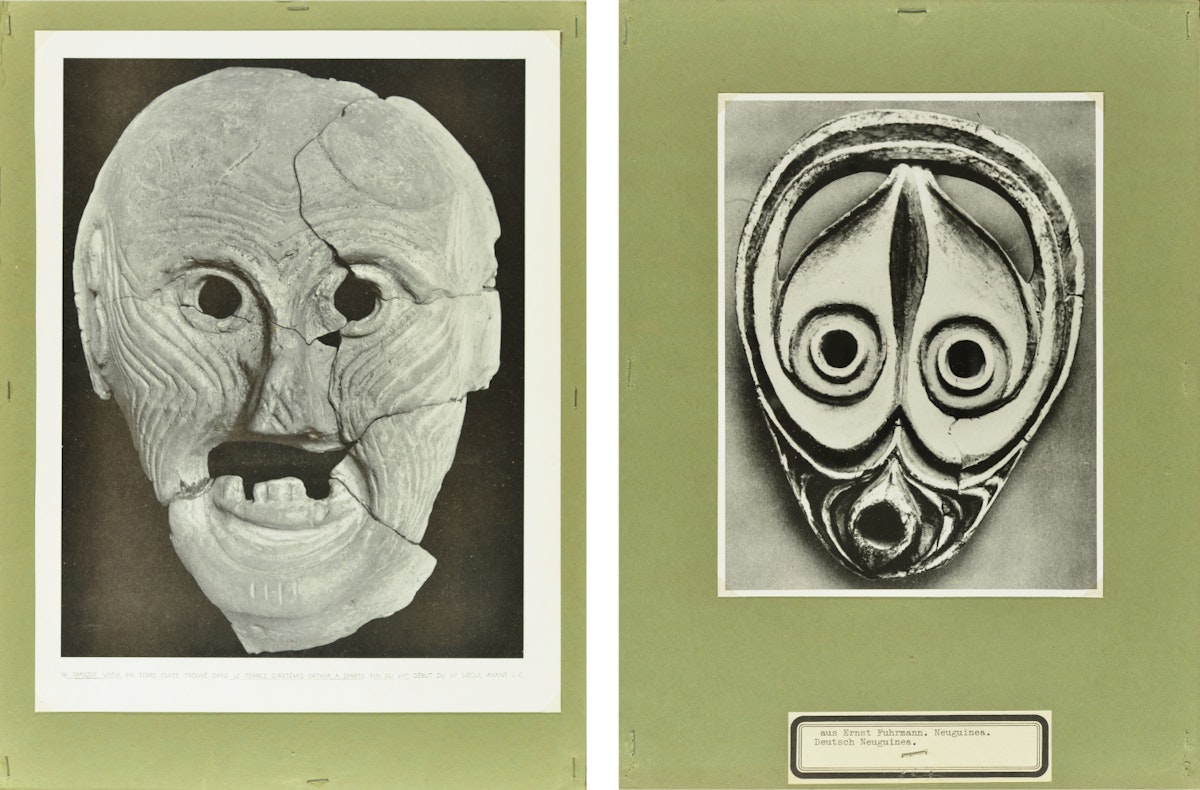 Scroll through the whole page to download all images before printing.
Scroll through the whole page to download all images before printing.Left: uncredited photograph of terracotta votive mask found in the Sanctuary of Artemis Orthia, Sparta, dating to ca. 600 BCE. Right: wooden mask from near the Sepik river in New Guinea, featured in Ernst Fuhrmann, Neu-Guinea (Hagen: Folkwang-Verlang, 1922). Author’s own photographs from the Eranos Archive at the Warburg Institute, London.
The name Eranos was suggested by the religious historian Rudolf Otto, the Greek word denoting an eating-together and thinking-together. Fröbe herself compared Eranos to a dance, in which the performers changed but the movement continued. Many “dancers” would devotedly return year after year, such as Indologist Heinrich Zimmer, classical philologist Karl Kerènyi, Gershom Scholem, founder of the modern academic study of Jewish mysticism, historian of religion Mircea Eliade, and, most importantly, the psychoanalyst Carl Gustav Jung.
In 1950, when Joseph Campbell was scrutinizing the Eranos lectures with the purpose of assembling a selection for the US market, he remarked that the commitment to facilitating understanding between “East and West” had gradually been abandoned. After 1939, only two papers treated people outside Europe and the Mediterranean sphere (one of them disparagingly) and there had been only one paper by a non-European scholar, Swami Yatishwarananda.15 Fröbe scoffed at such remarks, countering that the “reason for concentrating on the [Mediterranean] cultures was that there is the source of all Western culture, and as such already too great a task for us. So we had to leave the East. The title ‘Meeting place of East & West’ simply means, psychologically, ‘Meeting place of the opposites’”16 Fröbe had invited some of the foremost European experts on Asian art and religion, like Campbell’s mentor Heinrich Zimmer, but there is no doubt that the Eastern topics most dear to her, such as yoga, mandalas, and the I Ching, were understood through a distinctly European (that is, Jungian) lens. In other words, the Eranos audience was attracted to the spiritual phenomena of the “East” as tools for their personal journeys of individuation: the mental maturation that, according to Jung, resulted from an individual’s thorough confrontation with their unconscious. Eranos anticipated comparative religious and cultural studies in a way that was ahead of its time, but the comparison was to an extent predetermined by the conviction that all cultural expressions reflected something constant and omnipresent in the human psyche.
Jung’s theory of the collective unconscious provided a framework that linked the sprawling themes of the conferences and the wide-ranging expertise of the speakers. The 1938 conference on “The Great Mother”, for example, tied together Celtic goddess worship (V. C. C. Collum), the Anatolian Artemis of Ephesus (Charles Picard), and the Indian world mother (Heinrich Zimmer) into a search for the “unity of mankind”.17 This kind of comparative humanism held great appeal, as it offered a unique bridge between disciplines and historical epochs. The comparison of such seemingly unrelated cultural manifestations also, unavoidably, created reductive equivalences. Eranos’ comparative framework was geared from the outset towards similarities rather than difference. Regarding the image exhibition that accompanied the conference on the Great Mother, Fröbe wrote that it showed how “the conception of the feminine deity went back to prehistoric man . . . giving an historic series of the transformations of her image and of its many aspects”.18 Whether they treated their presentations as such, each lecturer could be understood as contributing specific examples of an eternal idea of femininity as described by Jung. To Fröbe, this was not about exploring the different associations that motherhood might have carried throughout cultural history, but showing how they all “stand for primeval ideas eternally existent in the psychic world, that have sought expression in every age and in every culture, and are today alive and active as in the beginnings of time”.19
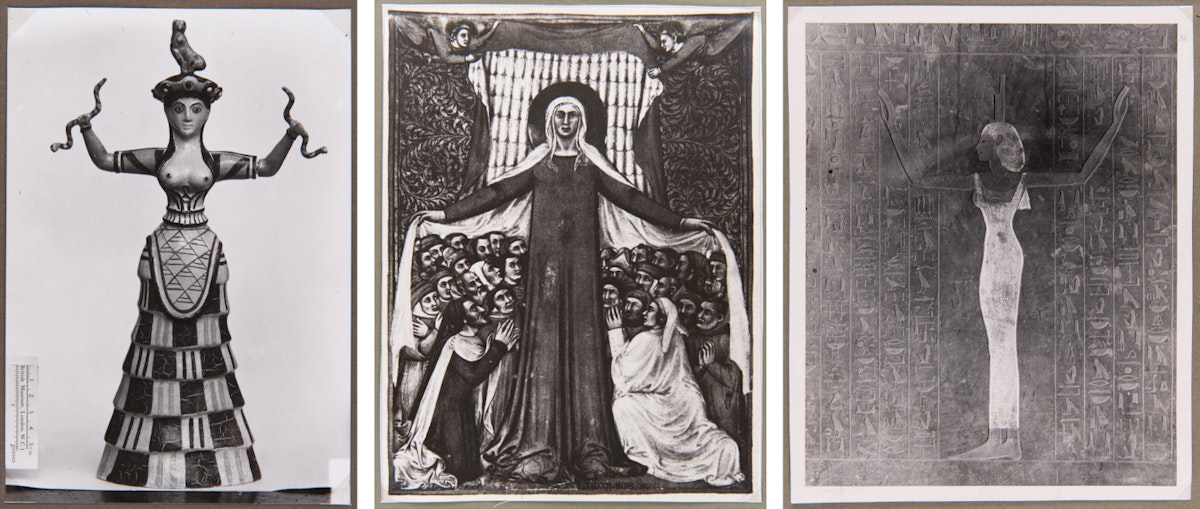 Scroll through the whole page to download all images before printing.
Scroll through the whole page to download all images before printing.Left to right: Photograph of a replica of a Minoan faience snake goddess votary, ca. 1700 BCE; unidentified reproduction of a painting of the Virgin of Mercy; photograph of Isis as depicted on a sarcophagus lid in the Tomb of Thutmose IV in The Valley of the Kings, Luxor, Egypt, ca. 1400 BCE. All images archived by Olga Fröbe-Kapteyn under The Great Mother — Source: left, centre, right (courtesy of the Warburg Institute, non-commercial use permitted).
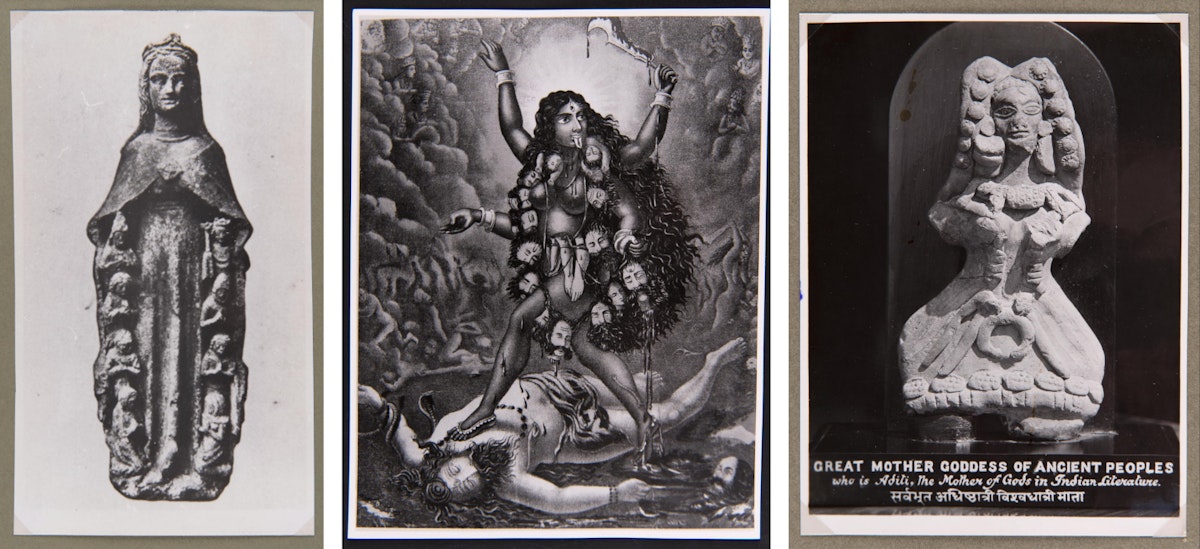 Scroll through the whole page to download all images before printing.
Scroll through the whole page to download all images before printing.Left to right: photograph of unidentified Mary sculpture; reproduction of Calcutta Art Studio image of the four-armed Kali, wearing the mundamala garland of severed heads, standing on Shiva’s chest, ca. 1908; photograph of Aditi statue, the Vedic personification of the infinite, ca. 200 BCE. All images archived by Olga Fröbe-Kapteyn under The Great Mother — Source: left, centre, right (courtesy of the Warburg Institute, non-commercial use permitted).
Collecting the Collective Unconscious
Fröbe developed her image archive in tandem with these conferences, and, in the early 1930s, she began collecting alchemical images for Jung. She travelled to libraries across Europe and eventually the US, photographing manuscripts, arguing with librarians, and updating her correspondents about the rudeness she encountered in Paris — where the library administrators sit “like demons on the books and manuscripts and becomes hostile when you force them to hand them over”20 — and the chaos in Athens: “Nothing is organised, nothing is permitted”.21 The photographs in the archive were mainly sourced from books; Fröbe rarely photographed objects. The publications she sought out, and arguably her own project, reflected the dream of “the universal archive”, an aspiration that had been reflected in Enlightenment encyclopaedic projects and ethnographic museums since the nineteenth century.22
Perennially troubled by finances, Fröbe wanted to turn image collecting into a profession and contacted the Warburg Institute in 1936, suggesting that they hire her to expand their own impressive collection on topics adjacent to alchemy. The cash-strapped Institute could not take up her offer, but Fröbe, with typical brazenness (“perhaps he thought I was some rich lady with my own personal research funds who could work for him for free”) was not discouraged.23 Help came from overseas. Encouraged by his wife Mary, Paul Mellon, co-heir to the Mellon family banking fortune, had developed an interest in Jungian psychology, and the couple were introduced to Fröbe and Eranos during a trip to Switzerland in 1938. With their funding, Fröbe could continue expanding the archive, although the support mostly fell short of her expectations. Under Mary’s leadership, the Mellons started the Bollingen Foundation — named after Jung’s ascetic tower retreat — which would support many scholars from the Eranos orbit (Mary sometimes called it “her Eranos”). William McGuire, in his extensive biography of the Foundation, likened Jung’s tower to a navel at the centre of the Mellon’s intellectual world: “if a being could have more than one, [Eranos] was Bollingen’s other omphalos”.24
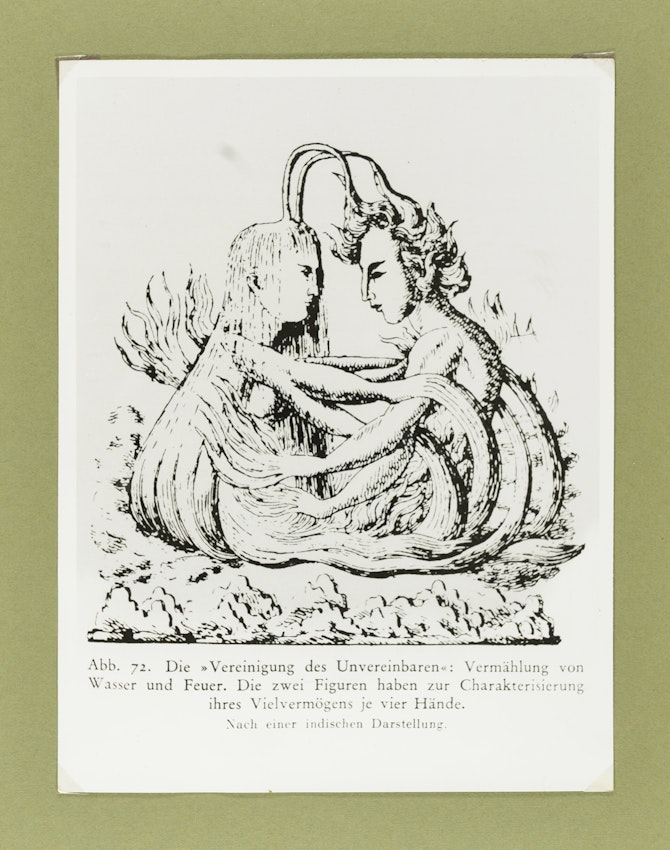 Scroll through the whole page to download all images before printing.
Scroll through the whole page to download all images before printing.The “union of the irreconcilable” — the marriage of water and fire — after an Indian depiction. The figures have four hands to “characterise their many abilities”. Image from Carl Jung, Psychologie und Alchemie (Zürich: Rascher, 1944), who sourced the illustration from Plate II of Niklas Müller, Glauben, Wissen und Kunst der alten Hindus (Mainz, 1822). Author’s own photograph from the Eranos Archive at the Warburg Institute, London.
Encouraged by this double-naveled philanthropy, Fröbe considered moving the archive to the US, safeguarding it from a possible German invasion of Switzerland during World War II. She was annoyed but undeterred after she attracted the attention of the FBI upon leaving the United States with a suitcase full of strange images.25 In 1941, Bollingen began planning an English-language volume based on the Eranos yearbooks. The project was soon shelved, partly because Fröbe would not accept cutting an essay by the Indologist Jakob Wilhelm Hauer, who had infamously tried to create a Nazi religion combining Protestantism and Hinduism. “It seems to me that the spirit of Eranos would be terribly boxed up, if considerations such as you mention are going to be taken into account”, she wrote in response to the Americans’ reservations, “after all philosophy, or comparative religion are realms quite outside politics of war”.26 Shortly after this, Bollingen was pressured to cease collaborations with Switzerland in order to placate American authorities.
During the war, the annual Eranos conferences were limited to Swiss participants. It was at this time that Fröbe imagined the archive blossoming into its final form. “It is a huge piece of work, [far] bigger than the above suggests and is a typical synthetic creation of the new age”.27 The archive was not an easy companion, however, especially not for Fröbe. Exceptionally attuned to metaphysical transference, she often found her own psychological journey reflected in the symbols at hand. Travelling to Crete in search of images of the Great Mother, the island and its mythology began to merge with her sense of self. Overwhelmed by visions, she identified first with the island and later reached the insight that she carried a reflection of the minotaur inside her: “Oh dear, those archetypes! what a plague they are”, she wrote to her friend in frustration.28 She kept the images in her bedroom, and she could sometimes feel them interfering with her health. “I sleep in the coll. Unc[onscious]”, she complained, and since archetypes do not require food or sleep, she too could not get proper rest and nourishment.29 Cohabiting with the images allowed them to creep back into Fröbe’s dreams, blurring the line between personal psyche and deep human history. After the war, when Fröbe could once more host international gatherings, she arranged for the images’ move to the Warburg Institute in London, where they remain today — an institution that, like her archive, was built on a grandiose vision for a new organisation of knowledge.30 After this move, Erich Neumann wrote to congratulate Fröbe that her room was once more fit for habitation.31
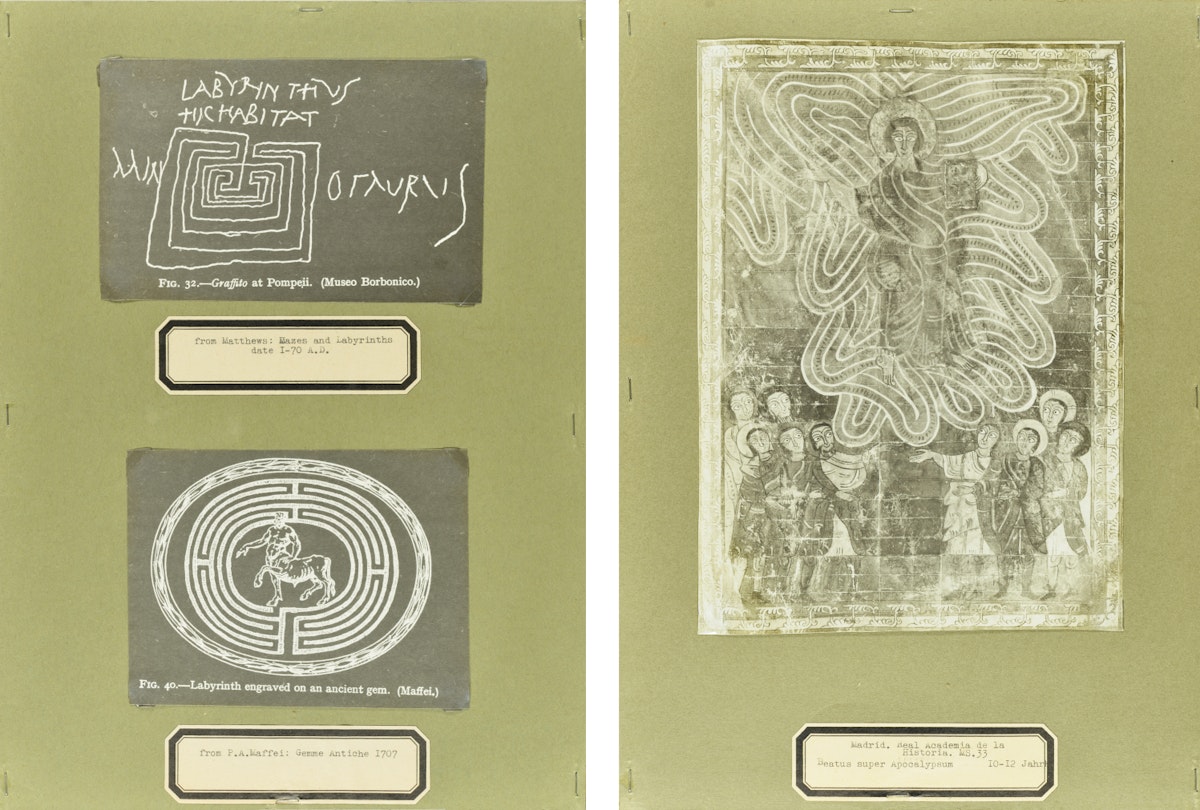 Scroll through the whole page to download all images before printing.
Scroll through the whole page to download all images before printing.Left (top): labyrinth graffito found at Pompeii, ca. 70 CE. Left (bottom): minotaur and labyrinth as engraved on ancient gem. Both images reproduced, in negative, from W. H. Matthews, Mazes and Labyrinths (London: Longmans, Green and Co., 1922). Right: illumination from Beatus of Liébana’s Commentary on the Apocalypse, illustrating the lines “Behold, he is coming with the clouds, and every eye will see him” from Revelation 1:7. Despite the reference given on the Eranos archive label, the image is from MS M.644 held by The Morgan Library, New York. Author’s own photographs from the Eranos Archive at the Warburg Institute, London.
The Eranos archive was supposed to draw out “the supra-personal in the personal and unique”.32 And yet, it became almost identical with Fröbe’s personal journey. Jung repeatedly cautioned her about identifying too fully with Eranos.33 She recognized that the process of collecting images was part of her individuation, a process that brought her ever closer to the archetypes, as when she readily identified as the mother of Eranos and her speakers, who were generally all too happy to play along. “I’m returning the images of the Great Mother to the Great Mother of Ascona”, Neumann wrote her.34
Critical evaluations of Fröbe’s legacy have pointed to her association with future Nazi sympathisers such as Hauer, while supporters emphasize her many collaborations with Jewish scholars. The relationship between Fröbe’s Eranos project and Fascism is both more entangled and more nebulous than her endorsement of individuals. Eranos was unique, yet also a project of its time. World War I, and the political instability preceding and following it in Europe, birthed a disillusionment with modern society and the dream of progress. The first decades of the twentieth century saw an increased fascination with mythology, the occult, and the archaic. For the Marxist critic Georg Lukacs, these “irrational” cultural tendencies, down to the experiments in back-to-nature lifestyles promoted on Monte Verità, all fit neatly in a trajectory leading directly towards fascism.35 The truth is likely better understood as a conceptual fork. Some thinkers interested in the occult’s fascination with the eternal and immutable folded these conversations into their ideologies of pacifism or feminism; others into fascism. As Hans Thomas Hakl writes, the National Socialists and Jung both “longed to experience a ‘sacred time’”: the former “were searching for a mythical primal era of the Aryan peoples, whereas Jung saw this [sacred time] as having been realized in the collective unconscious.”36
Fröbe was no Nazi sympathizer, and, more than anything, she insisted that Eranos was apolitical. Yet, in the middle of war, that amounted to a political position in its own right. “It is the only platform where representatives of the European intelligentsia can meet independently from political misunderstandings and tensions”, she wrote to Jung in 1942.37 Today the choice of the euphemisms “misunderstandings and tensions” reads as an absurd, even myopic, understatement. For Fröbe, however, the path inwards was not only more important than the outer world, it was the only path to healing a world in chaos.38 Fröbe’s prioritization of personal spirituality above social action poses the most difficult and perhaps most pressing dilemma for our own time: can turning inwards indeed bring about change in the world? Do we recognize a collective unconscious reflected in our individual lives, or do we rather project our personal concerns into the art of distant cultures? Where does contemplation retreat into complicity?
Frederika Tevebring is an intellectual historian interested in the ways that prehistory and antiquity have inspired artists and political thinkers. The research on Eranos is part of a larger project about how the theory of ancient matriarchies became a central idea for socialists, fascists, and feminists in the first decades of the twentieth century. She is a Lecturer in Global Cultures and Interdisciplinary Education in the department of Liberal Arts, King’s College London and holds a PhD in Comparative Literature from Northwestern University and a MA and BA in Religious Studies from the Freie Universität in Berlin. She has been the guest editor for a special issue on “Freud’s Archaeology” for American Imago.





